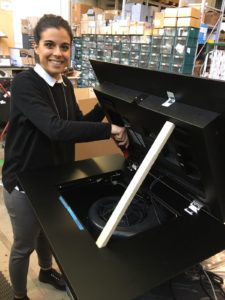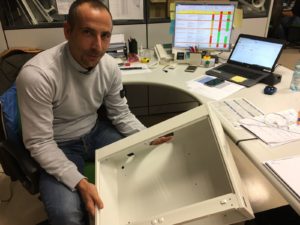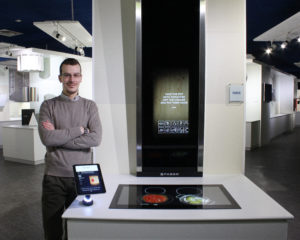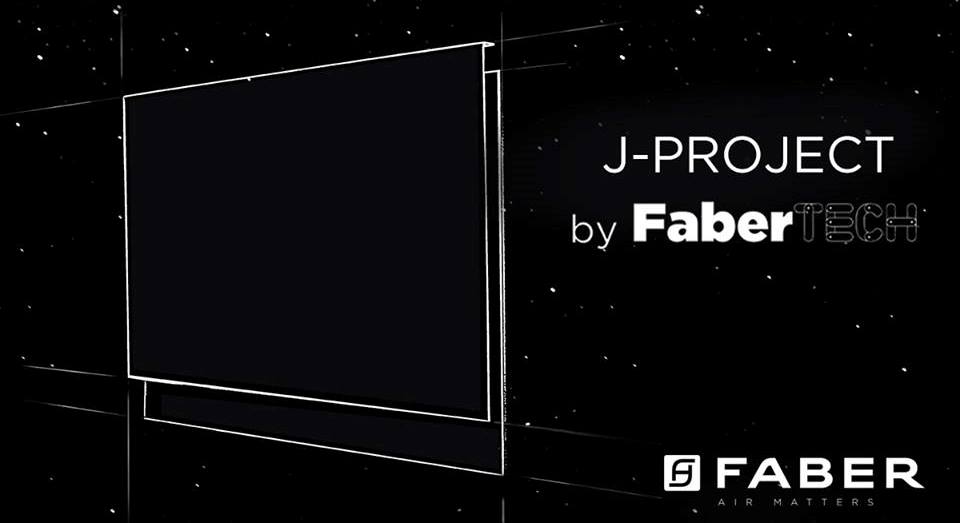J-Project is a customizable open source product that, thanks to the combination of the installed hardware and software, allows gaining access to internet, reading a video recipe or glancing at Twitter’s feed. As explains Alessandro Donnino, team leader of Faber Tech: the laboratory of under 35 engineers who have developed the project.
By Elviro Di Meo
J-Project is an open source hood, with fully customizable functions and components. Signed by Faber http://www.faberspa.com/en/, it represents a small great revolution at home. While we are cooking, we will receive and share information in real time, exploiting one of the most common, and often underestimated, household appliances. We will check, for instance, the levels of carbon monoxide contained in our house or adjust the humidity. Moreover, it will be possible to read the news on internet, follow a video recipe or looking at Twitter’s feed. Customization possibilities are virtually endless. «In the last few years, IOT, Internet of Things and Robotics have been highly topical issues concerning the phone and industrial automation sectors – Dino Giubbilei, Marketing Director of Faber Spa. With J-project, the concept of internet of things enters the suction hood world as well, thanks to a young team who has developed something innovative and futuristic indeed, combining primacy open source software, smart technologies, robotic engineering and know how». The hood integrates, in fact a SCK (Smart Citizen Kit) module, equipped with various sensors, like temperature, wetness, light, sounds, carbon monoxide, nitrogen dioxide and the available wi-fi nets. The front panel of the household appliance is a real interactive video. Besides the information collected by the sensors, it reveals tweets, news and images coming from external devices. Starting from the idea of “sharing to improve everyday life”, Faber engineers have given birth to a Software Development Kit (SDK) – which offers the possibility of making all modification types, to satisfy all needs – to the community of users, lovers and consumers. J-Project can be customized not only through the addition of sensors but also of apps and algorithms allowing the hood to interact with users. If the household appliance detected, for instance, a high humidity level in the kitchen environment through a specific sensor, it would suggest operating the suction filter to solve the problem. For the first time, customers’ personal requirements merge with the technology of products, diversifying and multiplying their functions. The design, currently in processing phase and therefore not in production, yet, has been developed inside Faber Tech: a laboratory of ideas and experimentations, sprung from the collaboration of 5 young Faber engineers – all Italians and from 30 to 35 years old – composed by Alessandro Donnino, team leader, Chiara Mariani, David Caracini, Enrico Erba and Michele Conti. Precisely Dino Giubbilei explains us the product characteristics.





From what does this new project stem? How does it work?J-Project represents the state of the art of Faber technology. Each element in this concept, not on trade, yet, is special indeed. It is an actual vertical hood that, thanks to the new diffuser Nautilus, with very small sizes, reaches the highest energy performances, raising to the A class some products that, generally, would belong to the C class. The hardware architecture- the hood core – is fully integrable with Arduino platform, then fully open source, and it can control the domestic pollution and the level of carbon monoxide, granting an adequate ventilation whenever necessary. Besides, J-Project is equipped with a big smart display, inserted into the front glass panel, which allows reading news on internet, browsing video-recipes, being connected with one’s own favourite social webs and combining devices like the smartphone. Obviously, being an Open Source design, customization possibilities are endless indeed and several still unexplored.
What are the technical characteristics and the innovations introduced into this future household appliance?
If we consider the product from a purely technical point of view, the characteristic that makes J-Project particular is the use of Nautilus: a surprising diffuser that in just 15 cm. of thickness allows the hoods integrating it to reach the A energy class. A relevant result, considering we refer to products that, with the previous technologies, would have reached a lower energy class. The small footprint of Nautilus facilitates its use especially in vertical hoods, which can feature a design characterized by surfaces perfectly perpendicular to the hob, as in the case of Talìka hood. In terms of innovations, the peculiarity is instead precisely the design of the first open source hood: in other words, a household appliance that dialogues with users and suits their requirements, simultaneously checking the air quality in the kitchen environment.
Could you explain better the function of Nautilus? From what does its name derive?
It was conceived to increase the energy efficiency of suction hoods. This new ventilating system allows achieving excellent results while decreasing the electric energy consumption. With unprecedented functions and a design mirroring the high Faber standards, Nautilus is a project that takes inspiration from nature. Just as its name indicates, the diffuser shape resembles the Nautilus mollusc, whose line, which regulates the shell growth, consists in the logarithmic spiral of the golden section.
What and how many were the phases that have led to the engineering and the prototyping of J-Project?
The prototype is fruit of three main phases: the definition of application cases and project requisites, the hardware and software engineering, the implementation of the various prototypes we exhibited at the trade fair – (Maker Faire Rome 2016, editors’ note). Each stage was a constant challenge for Faber Tech that, precisely thanks to its engineers’ entrepreneurship and will of innovating, has managed to overcome all difficulties, reaching the final target.
Once ended the lab phase, what is the final product design?
The one of a vertical hood, in the real meaning of the word. And we have attained this result with the use of Nautilus. Its small footprint permits the attainment of a hood that we can define as ‘a painting above the cooking zone’. The final design will strongly resemble Talìka’s: the brand-new model presented at the last edition of Eurocucina 2016.
How have you formed the team of engineers?
We intended to take part in Maker Faire with new proposals, attracting the public’s attention with a product not included in the catalogue, able to highlight the company’s innovative character. We brought together the Faber Tech laboratory of ideas, creating something unprecedented in the household appliance world. This resulted in J-Project: a concept that applies the open HW and SW model, which proved fine, functional and really innovative, complying with the maker spirit of the exhibition. The J-project lets the IOT concept enter inside the kitchen. We wanted to experiment new uses, approaching Apps and the connection with other devices, exploiting sensors and the possibility of introducing new functions.
What is the SCK module?
The Smart Citizen Kit or SCK is an open platform, based on Arduino, equipped with a set of sensors, which reveals the air quality, noise and light, able to send data to a central server that processes and visualizes them for all members of the community. Sharing these data, the platform sets the target of acting as local node of a globally extended network, aimed at supplying very useful information to all users. Is the air we breathe in the city, in the office or at home polluted? We can discover it with SCK and share this piece of information with others. In this way, we will be able to understand also how to improve the environment where we live, and then our life and of people we love.
What is the Software Development Kit? What are its applications?
We should imagine the SDK as a whole of SW instruments allowing applications, implemented by external developers, to read the inputs (sensors) and to set some controls (outputs), through a series of standardized methods.
What targets does the company want to hit manufacturing this item?
Releasing on the market a product that does not exist, yet, is certainly our first target. At the same time, Faber wants to remain faithful to the promise made to its consumers, proposing from time to time new but especially functional products.
How are the safety standards of J-Project granted?
Safety is one of the heartily felt issues for us and we are still evaluating each single aspect connected with it. Naturally, as it has always happened, each of our products undergoes the analysis of national and international certifying bodies that assess its full conformity with all regulations in force.




